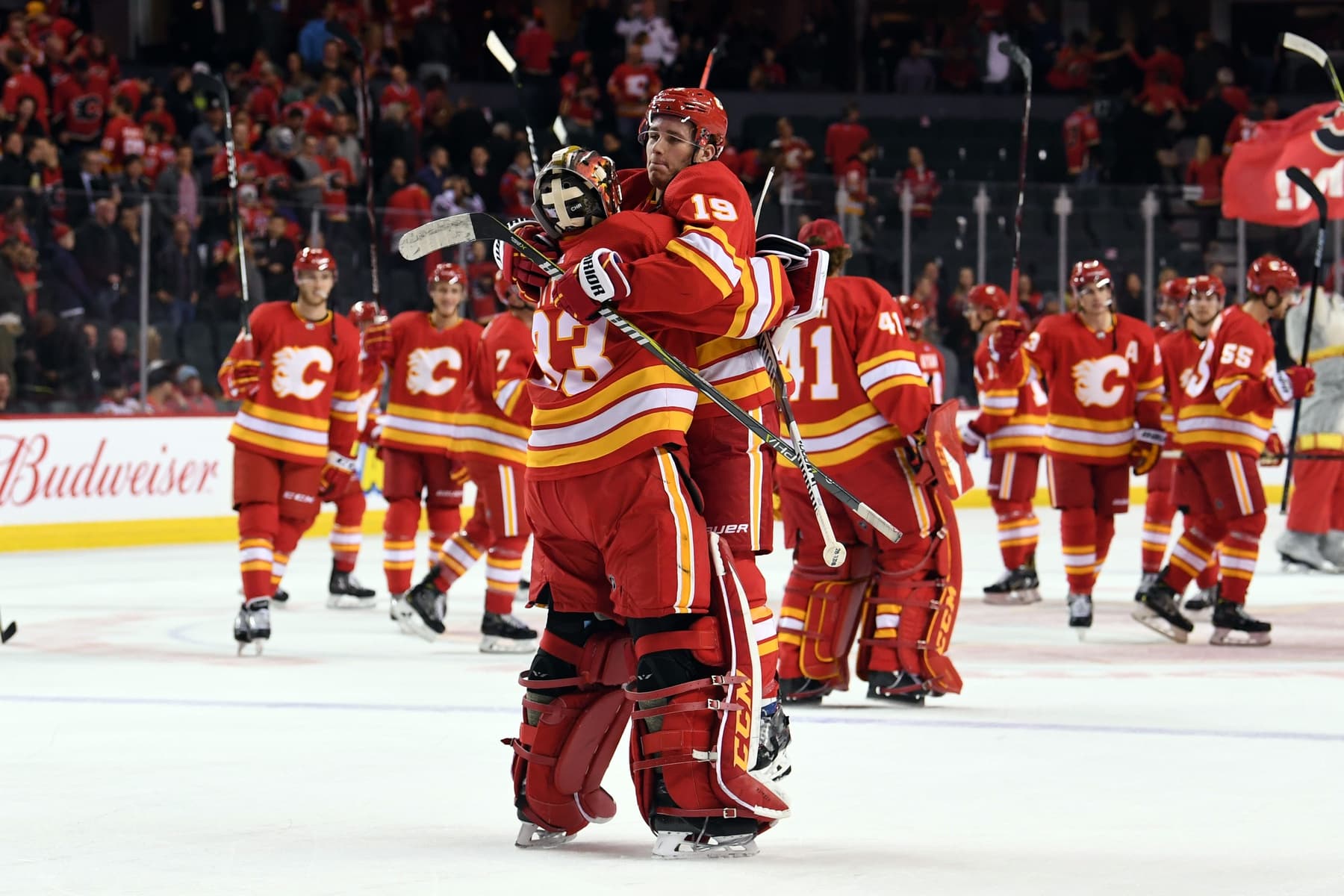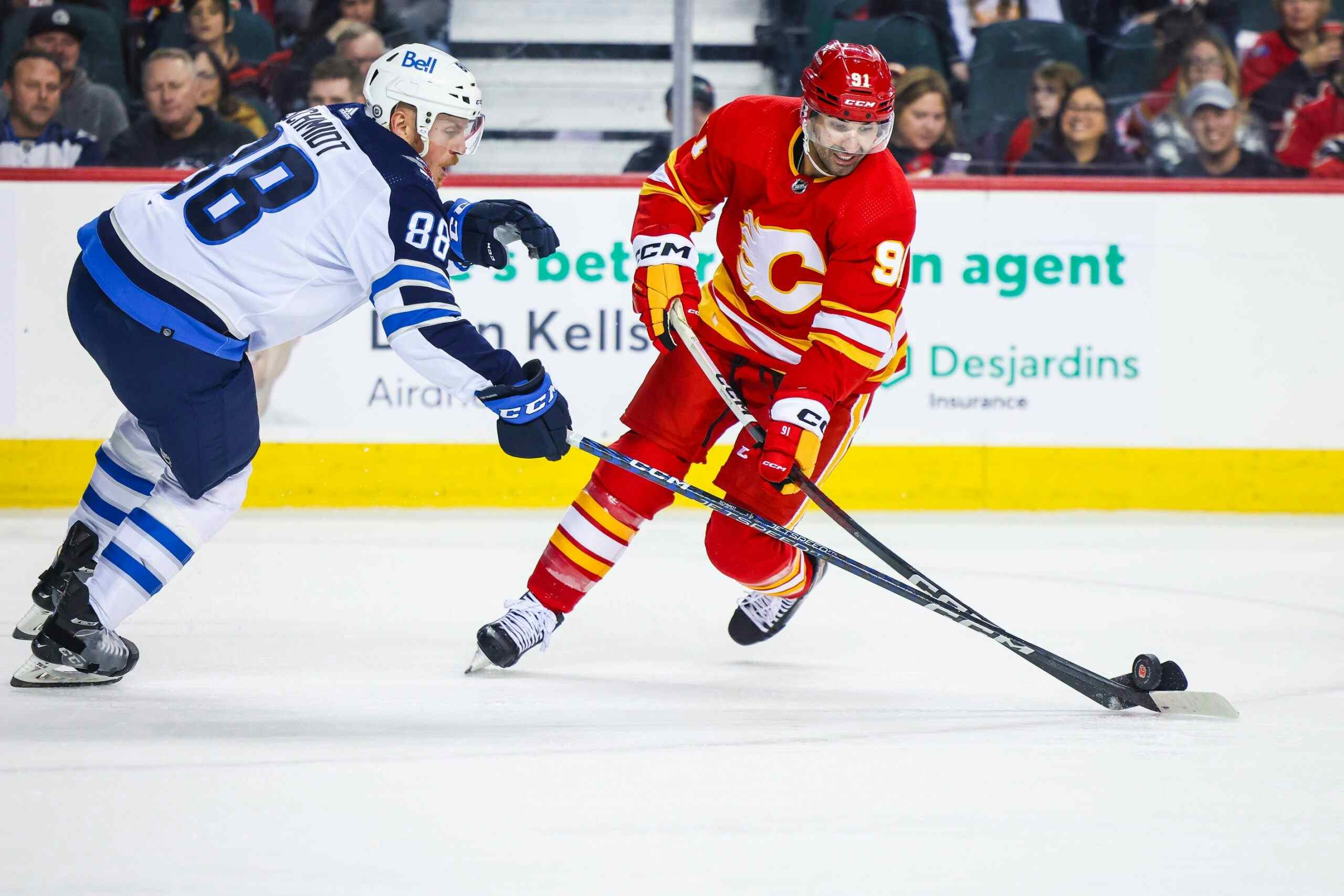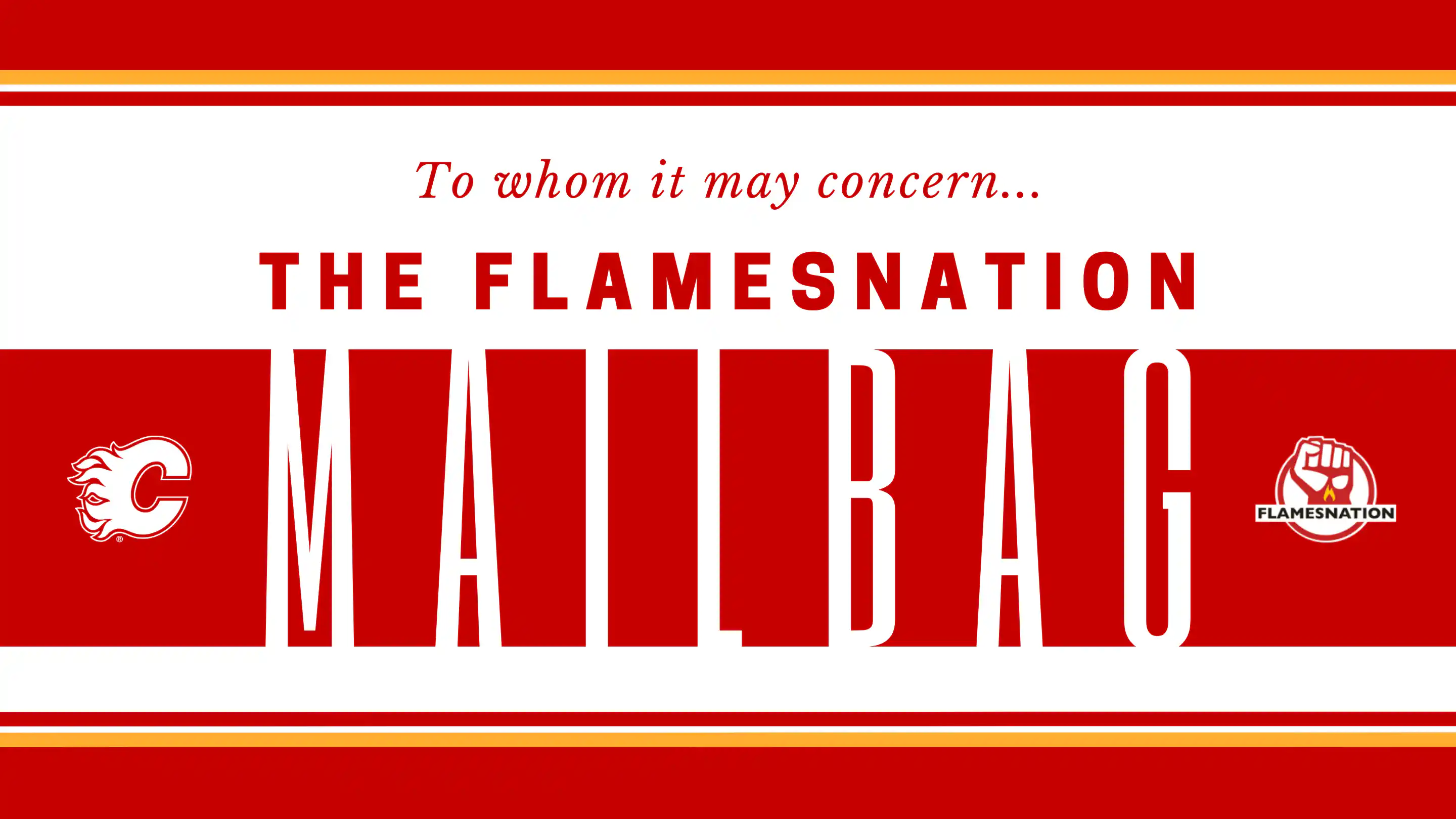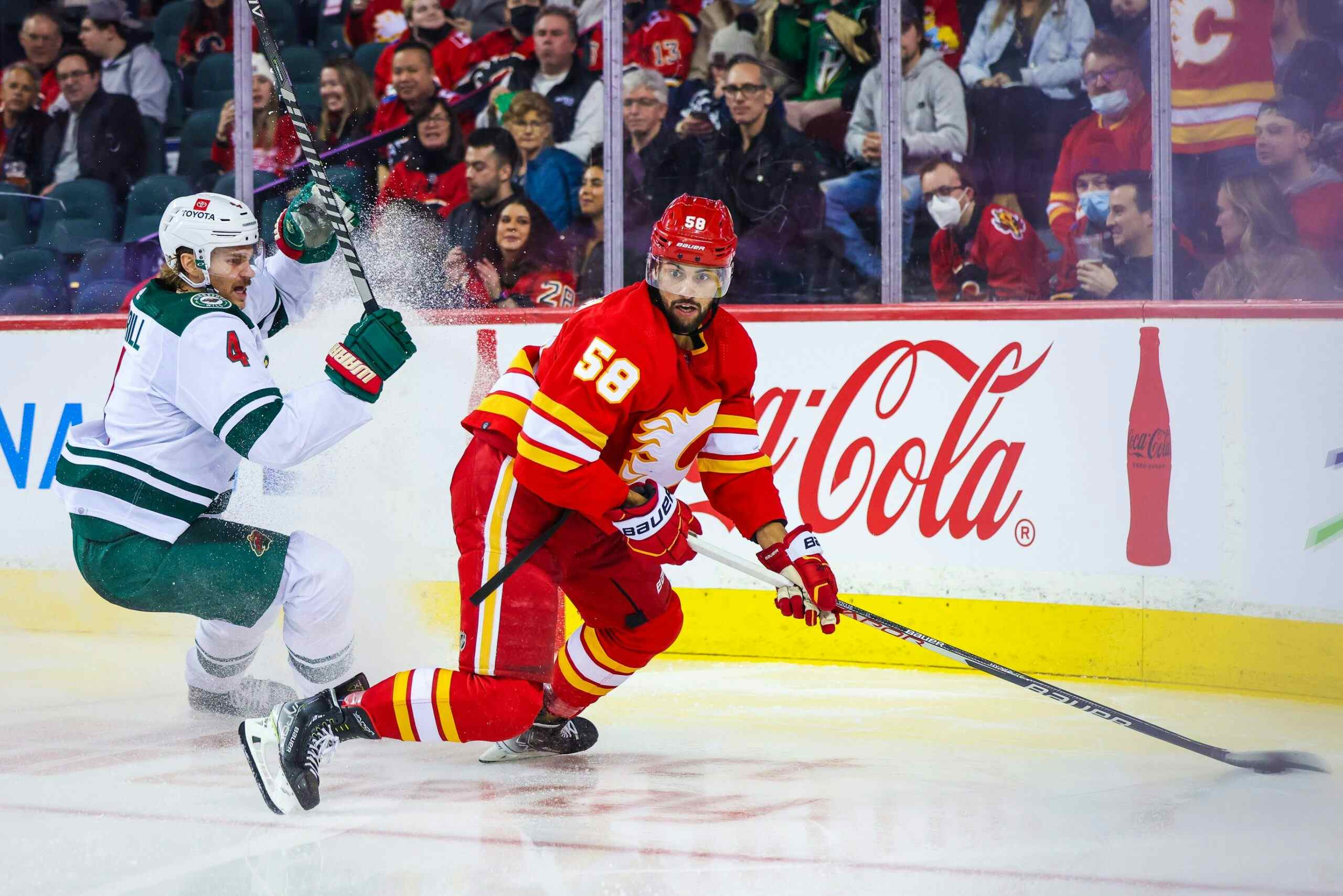Flames in 82 games: 50-25-7 in 2018-19 regular season

By Ari Yanover
5 years ago In Game 82, the Flames seemed to be focused only on getting Johnny Gaudreau to 100 points on the season. That, unfortunately, failed to happen; throw in a brutal injury to one of the game’s best players in Connor McDavid and there’s just nothing there. It was a meaningless game for both parties with any and all emotion sucked out of it.
There is, however, one number of note: Gaudreau’s 27:23 is the most he’s ever played in any NHL game. He’s played at least 26 minutes another three times this season. Including the fact that this is the first time he’s played 82 games in a year as well, this is easily the most hockey Gaudreau has played at the professional level – so it’s great that he’s still looking good on the ice and ready to go for the playoffs.
Speaking of those, the Flames are going to them. They finished the regular season as the second best team in the entire league, and one of just two teams to win 50 games – the other being the Lightning, who won 62 times. The Lightning are in a class of their own, but when it comes to the follow ups, at least, the Flames are right up there with the best of them. This is in a year in which they introduced all of their high level prospects to the NHL, spent most of the season with an all-rookie bottom defence pairing, and gave up no meaningful assets at the trade deadline.
The only thing that’s really in question: will Mark Giordano have a season this good again? He’s 35, and will go down as having one of the best seasons an older defenceman has ever had at this level. The Flames’ future may, in part, rely on whether he can keep his play up for the rest of his contract, but otherwise, the majority of the Flames’ elite players are either in their primes or just entering them – so the best may still be to come.
In the meantime, here’s to an excellent 82 games, the final three of which were meaningless and saw key players sitting. The Flames dealt with their fair share of injuries – mostly to Travis Hamonic, Michael Frolik, and James Neal – but have otherwise been blessed with consistency and relative health. Here’s to that keeping up as the real season finally begins: one that, back in October, we weren’t necessarily sure they were going to make it to; and one that, since the return from the breaks at the end of January, we were just waiting to find out the seeding.
And, of course, here’s to the stats. The Flames went 4-3-0 in their 11th seven-game segment of the season – throughout those segments, they only fell under .500 once – with links to all previous segments embedded there within.
As always, all underlying numbers are via Natural Stat Trick.
Team stats
| Stat | Points | Goals for | Goals against | Goal differential | PP% | PK% |
| 107 | 289 | 223 | +62 | 19.3 | 79.7 | |
| Rank | T-2 | T-2 | 9 | 2 | 18 | T-19 |
| Stat (5v5) | CF/60 | CA/60 | CF% | SH% | SV% | PDO |
| 60.66 | 52.02 | 53.83 | 9.09 | 91.81 | 1.009 | |
| Rank | 6 | 3 | 5 | 4 | 19 | 6 |
The Flames finished the season right near the top of the league in several categories, particularly goals scored, and corsi events at 5v5 as a whole. They had one of the best shooting percentages, which isn’t that much of a concern since it’s evident that even if the puck isn’t always going in, they’re doing the work they need to in order to create chances, regardless.
Their weaknesses relate to their goaltending – they’re pretty good at limiting corsi events against, but pucks still find their way in, and their save percentage isn’t great compared to the rest of the NHL – and special teams. The Flames fell from once having a top 10 powerplay, and they had to do a lot of work to get their penalty kill up as high as they eventually did.
Player stats
First, the forwards (all situations, ordered by ice time).
Game scores courtesy of our very own Ryan Pike: 0.950 and above is considered great; 0.450-0.950 good; 0.150-0.450 fine; -0.150-0.150 bad; under -0.150 awful.
| Player | TOI | Goals | Points | P/60 | SH% | CF% | GF% | OZS% | Game score |
| Gaudreau | 1646:04 | 36 | 99 | 3.61 | 14.69 | 60.34 | 64.53 | 68.96 | +1.343 |
| Lindholm | 1623:07 | 27 | 78 | 2.88 | 14.84 | 56.11 | 61.58 | 53.47 | +1.069 |
| Monahan | 1486:16 | 34 | 82 | 3.31 | 16.11 | 59.83 | 62.50 | 70.02 | +1.161 |
| Tkachuk | 1407:55 | 34 | 77 | 3.28 | 16.43 | 62.45 | 65.85 | 67.15 | +1.138 |
| Backlund | 1377:40 | 21 | 47 | 2.05 | 10.24 | 54.86 | 58.96 | 51.12 | +0.841 |
| Ryan | 1118:07 | 13 | 38 | 2.04 | 12.62 | 52.73 | 56.57 | 45.67 | +0.576 |
| Jankowski | 1003:55 | 14 | 32 | 1.91 | 14.14 | 47.11 | 45.05 | 41.59 | +0.443 |
| Bennett | 943:34 | 13 | 27 | 1.72 | 11.30 | 56.12 | 51.14 | 63.95 | +0.503 |
| Neal | 942:22 | 7 | 19 | 1.21 | 4.96 | 55.83 | 53.42 | 65.22 | +0.452 |
| Frolik | 868:28 | 16 | 34 | 2.35 | 12.12 | 54.50 | 59.77 | 53.28 | +0.758 |
| Hathaway | 800:01 | 11 | 19 | 1.42 | 14.29 | 44.60 | 53.45 | 47.79 | +0.306 |
| Czarnik | 611:58 | 6 | 18 | 1.76 | 9.23 | 57.30 | 50.98 | 61.57 | +0.449 |
| Mangiapane | 463:55 | 8 | 13 | 1.68 | 12.31 | 55.45 | 66.67 | 60.00 | +0.469 |
| Dube | 251:40 | 1 | 5 | 1.19 | 4.55 | 46.59 | 50.00 | 62.64 | +0.192 |
| Quine | 123:28 | 3 | 5 | 2.43 | 27.27 | 48.97 | 55.56 | 52.63 | +0.273 |
| Lomberg | 27:55 | 0 | 0 | 0 | 0 | 27.27 | n/a | 55.56 | -0.244 |
| Rychel | 18:21 | 0 | 0 | 0 | 0 | 36.36 | 50.00 | 40.00 | -0.268 |
| Peluso | 16:27 | 0 | 0 | 0 | 0 | 48.15 | 0.00 | 25.00 | -0.019 |
| Lazar | 4:48 | 0 | 0 | 0 | n/a | 55.56 | 0.00 | 75.00 | -0.030 |
The Flames had a great group of forwards suit up for them this season, highlighted by none other than Gaudreau, who was far and away the team’s offensive leader. He had an excellent supporting cast, however: high first round draft picks in Sean Monahan and Matthew Tkachuk, as well as Elias Lindholm, whose arrival to the Flames seemed to finally solve the first line right wing problem. The four are, without question, elite.
Mikael Backlund was the next best forward, as he had been throughout the year, scoring at a good clip while being asked to play more of a defensive role. Frolik followed him up, and likely would have had better counting numbers had he not been injured through November and December – and had he not been relegated to the fourth line and press box at times. He proved his worth as the season went on, reclaiming his spot on Backlund’s wing and refusing to let go.
The next best forward the Flames had to offer was a newcomer in Derek Ryan, who had an unimpressive start to the season. However, once he got settled in, he showed why he was a good free agent pickup, providing the Flames with another centre they could count on to play tough minutes. That he picked up the pace in scoring was a major bonus.
Sam Bennett had an up and down season, unable to nail down a spot on Backlund’s wing, but ultimately contributing as a decent depth player, capable of both extreme highs and lows – at least when he wasn’t injured.
Andrew Mangiapane didn’t make his way onto the team until December. While he seemed to struggle to find his footing in the NHL, he took off once he scored his first goal in early February. Playing alongside Ryan gave him a player of similar talent level he could feed off of: a high-quality linemate despite playing low-minute and low-leverage situations. Before, he looked like an AHL/NHL tweener; now, it looks like his home is in the NHL.
Neal did not have the season that was expected of him at all. For the first time in his career, he failed to score 20 goals, let alone 20 points. Games missed had a part in that; fatigue from going to back-to-back Stanley Cup finals may have, as well; a shockingly low 4.96 shooting percentage certainly didn’t help, either. Despite the rough scoring numbers, there aren’t really any red flags in his underlyings: he can still play at this level, and a bounce back next season isn’t out of the question (remember Frolik’s 2017-18?). That doesn’t erase how poorly this year went, but there’s hope yet.
Austin Czarnik struggled to get into the lineup, but when he was granted a spot – albeit often due to someone else’s injury – he performed well, and was a part of the Flames’ forward depth that saw them experience so much success. Mark Jankowski, meanwhile, followed up his rookie season with a steady sophomore performance, but his breakout role was as a high-scoring penalty killer.
Garnet Hathaway was the weakest among all Flames regular forwards, but a high shooting percentage, combined with good penalty kill performance, and regular minutes alongside Ryan still saw him have a good year. Basically: one can’t really go wrong with the group this team has, and from top to bottom, it’s a scoring threat.
Alan Quine looked to be a decent fill-in for further injuries. A couple of other players briefly experienced call-ups, but none were quite up to the task of playing at the NHL level.
Except, of course, for Dillon Dube, who started the year in the NHL and has put up good numbers in the AHL once he was demoted about the time Mangiapane started to become a regular. Mangiapane is a third-year pro; Dube is a rookie pro. His time will, in all likelihood, come.
Now, the defence (all situations, ordered by ice time):
| Player | TOI | Goals | Points | P/60 | SH% | CF% | GF% | OZS% | Game score |
| Giordano | 1890:39 | 17 | 74 | 2.35 | 7.69 | 56.75 | 61.54 | 48.58 | +1.164 |
| Brodie | 1696:13 | 9 | 34 | 1.20 | 8.82 | 54.06 | 54.34 | 47.50 | +0.664 |
| Hanifin | 1661:52 | 5 | 33 | 1.19 | 4.31 | 51.88 | 51.83 | 50.10 | +0.524 |
| Hamonic | 1439:43 | 7 | 19 | 0.79 | 5.47 | 48.66 | 50.31 | 39.84 | +0.599 |
| Andersson | 1267:07 | 2 | 19 | 0.90 | 1.74 | 52.84 | 60.95 | 60.16 | +0.369 |
| Kylington | 472:01 | 3 | 8 | 1.02 | 14.29 | 48.62 | 55.56 | 61.76 | +0.176 |
| Valimaki | 371:36 | 1 | 3 | 0.48 | 3.57 | 47.68 | 37.93 | 62.37 | +0.202 |
| Prout | 262:19 | 1 | 2 | 0.46 | 7.14 | 47.95 | 48.00 | 50.00 | +0.178 |
| Fantenberg | 237:25 | 0 | 1 | 0.25 | 0 | 55.01 | 62.50 | 56.45 | +0.353 |
| Stone | 223:06 | 0 | 5 | 1.34 | 0 | 48.81 | 39.13 | 49.28 | +0.321 |
To go with their deep forward group, the Flames have a deep defensive setup to match. Giordano was easily the best among them, but that’s hardly a surprise: he’s probably going to be given a trophy at the end of the year for being the best defenceman in the NHL, period.
He had a good supporting cast, too. TJ Brodie had his ups and downs throughout the year, but overall returned to being a good complement for Giordano: an outstanding skater capable of putting up points while taking on top competition and tougher zone starts.
After Giordano, though, the story of the Flames’ defence may be Hamonic. After a rough first season with the Flames, not to mention injuries befalling him throughout the season – including right at the start – he rounded into form, ultimately becoming one of the Flames’ top defensive players. Though not relied on for offence, he scored at a pretty decent clip as well, making him a threat at both ends of the ice. His partner, Noah Hanifin, had some struggles of his own throughout the season as Brodie did, but ultimately rounded out a good top four.
And then, of course, there was the Flames’ rookie of the year. Rasmus Andersson didn’t start the season with the Flames, the beneficiary of Hamonic’s early injury to getting some games in. Once he dressed, though, he made it impossible to keep him out of the lineup as it became clear he was better than some veterans on the team. His scoring touch came along, and he not only received powerplay time, but was occasionally called upon to play on the top pairing alongside Giordano. The rookie errors he made in October looked to be largely gone by March; his growth into an NHLer was fast and a true joy to watch, and he gives the Flames that much more of an edge on defence.
Oscar Fantenberg was a trade deadline pickup who slid right into his role as the team’s sixth defenceman: solid, steady, and dependable. A blood clot saw Michael Stone miss most of the season; he had already been outplayed by a couple of rookies, and though a capable veteran, the amount of time he’s missed might be some cause for concern when it comes to ramping everything up for the playoffs.
Juuso Valimaki made the Flames out of camp, and Oliver Kylington was his rookie replacement when injury claimed the better part of his year, starting in late November. Valimaki showed flashes of what he’ll likely grow into, while Kylington did a good job holding down the fort for about half of the season, before the Flames traded for Fantenberg: he probably wasn’t supposed to get that much NHL time this early, but that he was able to perform at the level he did is a testament to his own growth, as well. The Flames relied on three rookie defencemen throughout the year, and all three helped them.
Dalton Prout is depth; it’s hard to go wrong with having 10 defencemen used to the rigours of the NHL in some fashion.
And finally, goalies (all situations):
| Player | TOI | SV% | ldSV% | mdSV% | hdSV% | Game score |
| Rittich | 2503:19 | 0.911 | 0.944 | 0.918 | 0.837 | +0.670 |
| Smith | 2400:19 | 0.898 | 0.959 | 0.887 | 0.814 | +0.349 |
Goaltending has been the Flames’ Achilles heel this past season, relying on a now-37-year-old with an injury history, and an undrafted 26-year-old seeing just his second season with substantial time in the NHL.
Mike Smith struggled throughout the year, putting up poor performances to start that saw him never really clear the .900 save percentage hurdle at any point. There were times in which the goaltending was so poor he near-singlehandedly cost the Flames games, to the point at which the team just made Rittich the outright starter by mid-November – and he ran with it.
Though Rittich, himself, eventually came into some struggles: namely, a couple of really poor moments against some top tier teams, during which either he was at fault (a terrible start against the Sharks in early February), the entire team was (everyone getting collectively outplayed and destroyed by the Lightning in mid-February), or he was just a victim of absolutely horrendous luck (facing the Leafs in early March). From there, Rittich’s time as a starter oscillated back towards Smith, who succeeded in putting up good numbers against weaker teams, and was often the beneficiary of strong play from the rest of the lineup when facing stronger opponents.
Throughout it all, though, Rittich has unquestionably had the better numbers, and has just looked much more solid and composed in net in general. Though he wasn’t perfect himself – his numbers did start to fall in the second half of the season, going from one of the best in the NHL to just outside the top 30 – he was the better Flames goalie throughout the entire year.
The Flames have had problems with goaltending since Miikka Kiprusoff retired, though, and the future still isn’t clear as far as their net is concerned. If anything can bring this team down, it’ll probably be the goaltending.
Recent articles from Ari Yanover





